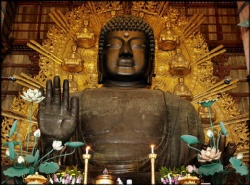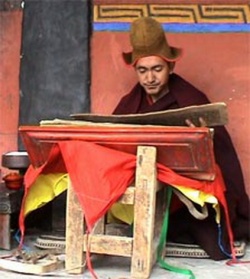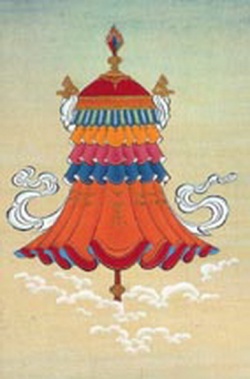Maha-prajna-paramitopadesa
Later, a biography of the bodhisattva Nāgārjuna entitled Long-chou-p’ou-sa-tchouan (T 2047) and published under Kumārajīva’s name was circulated. It has been translated into English by M. Walleser.65 It probably collected some information previously furnished by Kumārajīva,66 but he was not the author.
Firstly, the first catalogue to mention it was the Li-tai-san-pao-ki (T 2034, k. 8, p. 79a7) compiled at Tch’ang-ngan in 597 by Fei Tchang-fang and, contrary to his custom, this editor was unable to refer to any earlier catalogue.
Secondly, this biography, which correctly mentioned the Upadeśa in 100,000 gāthās (T 1509) and the Madhyamakaśāstra in 599 gāthās, also attributes to Nāgārjuna three works unknown as yet and which will not be considered further: a śāstra on the marvelous Bodhi of the Buddhas in 5,000 gāthās, a śāstra on the skillful means of great compassion in 5,000 gāthās and a śāstra on the absence of fear of which the Madhyamakaśāstra would be an extract.67
Finally and above all, this biography presents its hero as a high-flying adventurer and complacently describes his stormy youth, his exciting voyages, his daring attempts at reform, his sensational discoveries in the Nāga palace, his quarrels with the prince, his magic contests with the Brāhmins and finally, his mysterious death. The picture thus sketched gives a good idea of what the upper middle ages thought of a siddha, but corresponds poorly to the image that we ourselves have of this penetrating and rigorous logician who was the author of the Madhyamakaśāstra, this wise encyclopedist who was the author of the Upadeśa.68
You can check out Volume iii, from the link above to the Gampo Abbey translation. It has all the details, and considering it is online, I don't need to cut and paste here.
Strangely enough, I can't find the details there, but it goes like this:
A talented genius of a young brahmin, he learnt all sorts of magical arts like invisibility, and with his friends, thus secretly snuck into the king's harem. When the harem girls became pregnant, the king set a trap, and although Nagarjuna escaped, his friends were caught and executed. He saw the impermanence of life, and became a bhiksu. He mastered the Tripitaka in three months, but was still unfullfilled. He then when meditating, and learnt some Mahayana sutras from an old mahayana bhiksu in the (Himalaya?) mountains. Then, seeking more, he was led by the Naga king to the Naga realm, where he received huge amounts of Mahayana texts, many of which he brought back to the human realm. etc. etc.
Yinshun makes good arguments about the "Naga realm" story being linked to a place on the SE coast of India, old Mahasamghika territory, where there was strong worship of Naga spirits in a shrine there. Later, that shrine became something of a shrine to Nagarjuna, where he was "worshipped like a Buddha" in later centuries. ie. the "naga and naga realm" may have been a way of describing a naga shrine.
Also, "naga" was a name for a sage / holy man (even in India to this day). So, the story may not be as far fetched as literalists (who don't have context) may make it out to be.
Maybe some people are wondering why all this importance placed on this so-called Mahaprajnaparamita Upadesa? Most Western Buddhists have barely or never even heard of it, even if they are serious Mahayana practitioners and study Nagarjuna. This is simply due to the fact that it does not exist in Sanskrit or Tibetan, and thus is overlooked by most Western scholars and practitioners, or easily rejected as "not written by Nagarjuna" (even though the same people often study a lot of Candrakirti, Santideva, and the like). In China and East Asia, this is an extremely important text. It is not only one of the most important texts for the East Asian Sanlun - Madhyamaka school, but also is cited by pretty much every other school as well (except maybe the Tantric and Vijnaptimatra schools). Problem is, it is in Chinese, and it is also very, very huge. Still, if one is looking for a single text which is representative of much of Chinese Buddhism, this is probably the best one in the end.
When I teach this text, I usually begin by pointing out Nagarjuna's (for most regular classes at our Dharma centers, I just run the line that he is the author) usage of a variety of texts. When presenting a point or doctrine, he has a kind of hierarchy that he follows, something like this:
1. Agamas
2. Vinaya
3. Abhidharma (Sarvastivada, but often non-orthodox Gandhari, not just Kasmiri)
4. Mahayana Sutra (esp. Prajnaparamita)
5. Madhyamaka sastra
This is for general doctrines, eg. insight contemplations, etc. However, for Buddhological stuff, slightly different:
1. Agamas
2. Vinaya
3. Abhidharma
4. "Bodhisattva literature" = Jatakas, Avadanas, Nidanas, etc.
5. Mahayana Sutra
So, as I mentioned in this thread (?) earlier, although the approach is very inclusive, it is stratified, as to which is neyartha and which is nitartha. This is important, because I find that a lot of western practitioners who are more inclined towards a particular school are quite sectarian, and are not so inclusive, and rather than using the traditional neyartha / nitartha hermeneutics, they simply reject what does not match their favored school.
Thus, a main difference between Nagarjuna and Theravada, is that the Theravada in the end takes the Abhidhamma / Atthakatha as nitattha, whereas Nagarjuna takes Madhyamaka as nitartha. Of course, his Madhyamaka is itself based on Agama, too. So, in my mind, these are really more like parallel systems of thought, different ways of understanding the Agamas and Vinaya. Remember, Nagarjuna is a couple of centuries before Buddhaghosa.
this is indeed the version that Kalupahana refers to. In his Preface, p. vi, he says: "... I began to realize how Candrakirti was gradually leading me away from Nagarjuna's philosophical standpoint" ... "meeting with some scholars who were brought up in the Vedic tradition, I found them to be extremely comfortable with Nagarjuna as expressed by Candrakirti, and less impressed by the teachings of early Buddhism as recorded in the Nikayas and Agamas". ... "I found no justification whatsoever in looking at Nagarjuna through Candrakirti's eyes when there was a more faithful and closer disciple of Nagarjuna in Kumarajiva".
How many publications do we see about Nagarjuna that take this commentary as a key element are there? Very few indeed.


